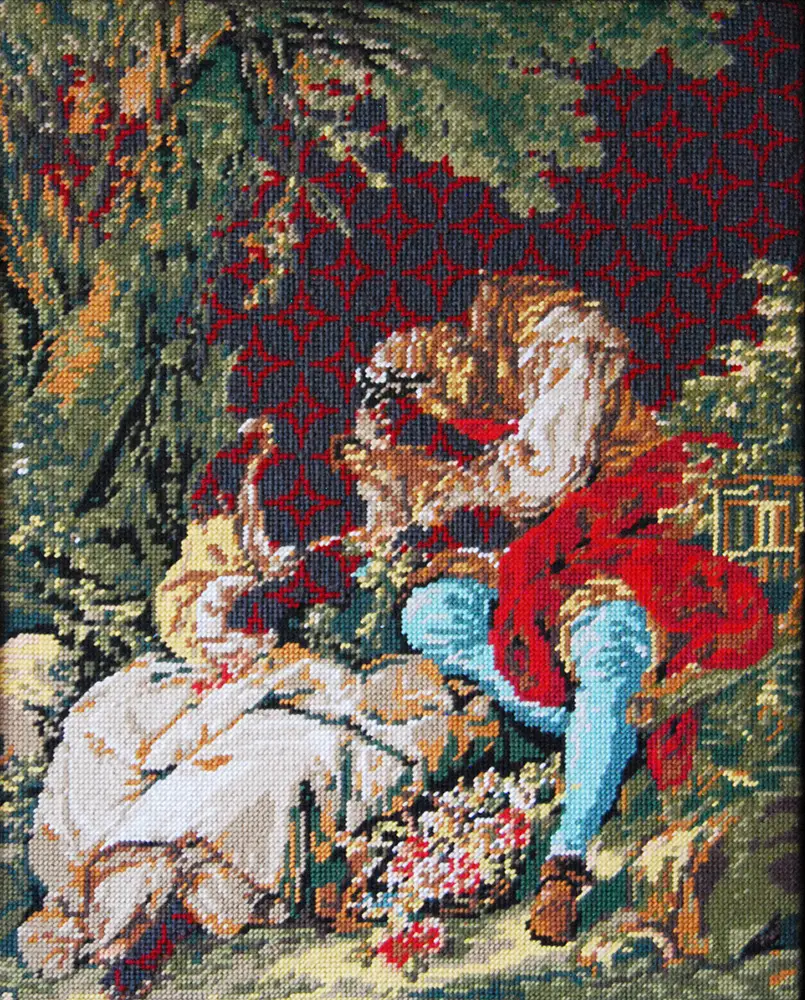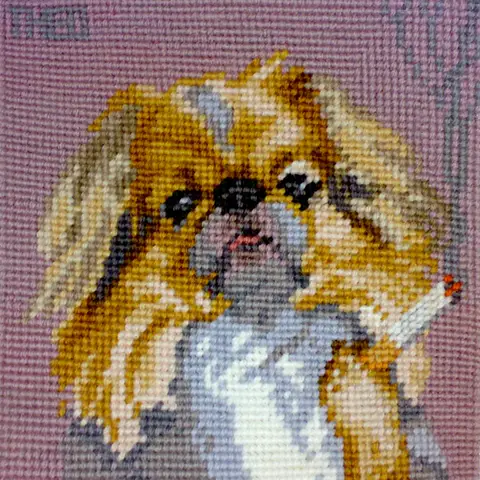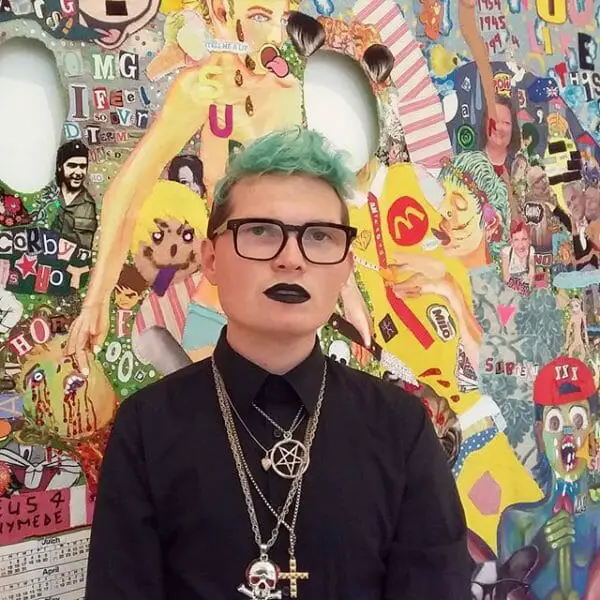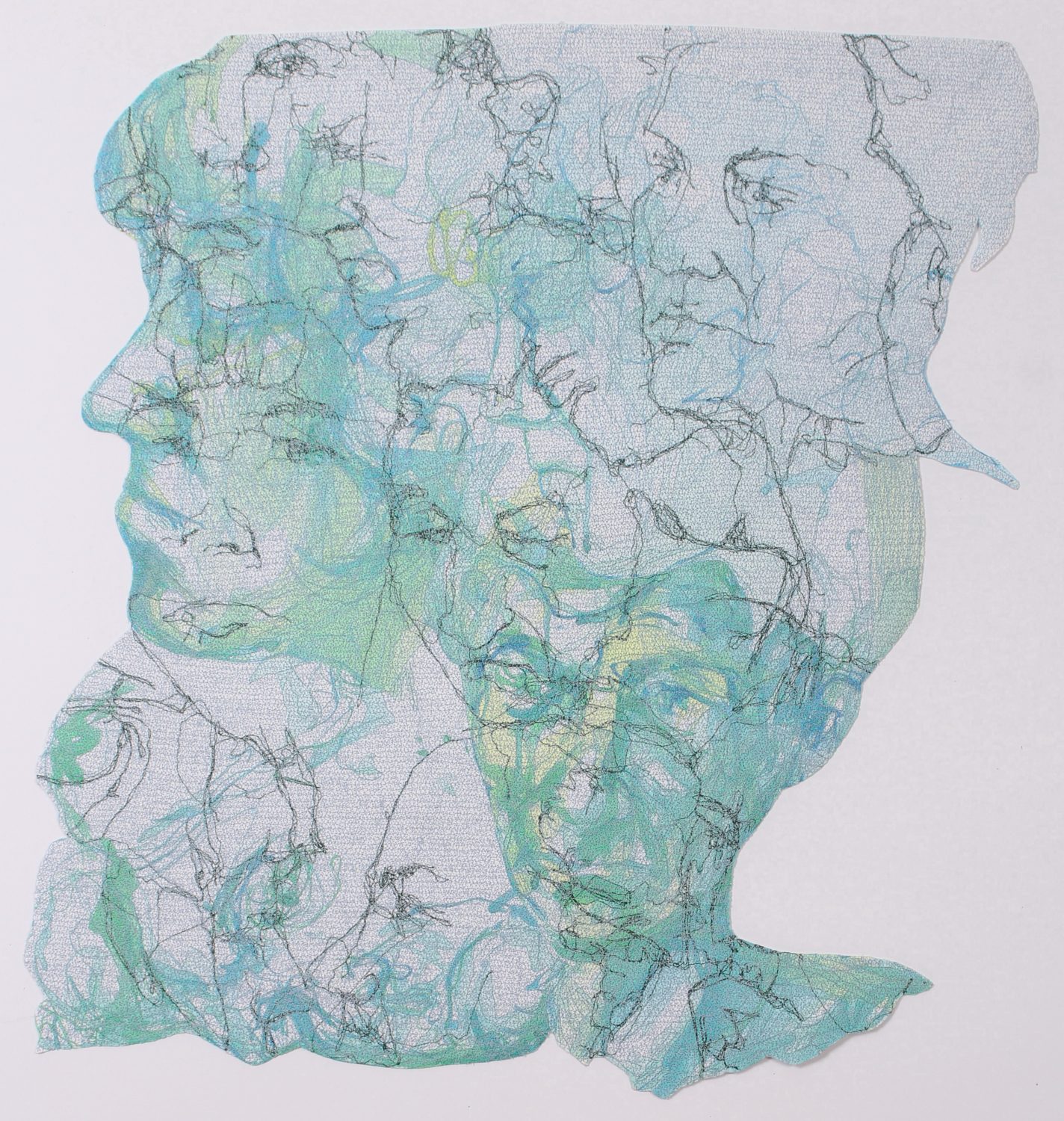
Welcome to Manbroidery, an ongoing series of interviews with men who stitch. This time we welcome Oliver Bliss whose large-scale machine stitched tapestries explore the reality of modern manhood.

Name: Oliver Bliss
Location: Worcester, UK
Main embroidery medium: Pictorial Tapestries
Noteworthy projects or pieces: #SoftLads my first solo series commissioned by Shout! Queer Arts Festival and in partnership with The Word Association, Arts Council England and Worcester City Council.

How did you come to be an embroiderer?
I first became interested in sewing when I went to an exhibition Boy Who Sew it was The Craft Council’s exhibition, and brought together a group of international male artists who break down barriers between fine art and fashion, exploring issues of gender, sexuality, race and identity. The exhibition explored issues of gender and why artists engage with ‘handmade’ techniques to development their visual art practice. It transformed my practice as I mainly worked in oils and mixed media at the time. Then when I went to University my Tutor encouraged me to invest my student loan in buying a sewing machine. I did and I had that for 16 year until it recently broke due to this latest project! It was the best investment I made during that course.
What does it mean to you?
I think that textiles as a practice can be woefully misunderstood and over looked by wider artistic community. I think there is a growing body of people internationally who are ignoring dominant trends about contemporary practice looks like. There is a subtle revolution happening constantly within the crafting community. We are individually experimenting and sharing our interests and connecting more openly with each other. I personally like how threads and fabrics have been figuratively and literarily woven stories throughout history. How these materials can be symbolic of our identity and status as well as a medium for wider communication. I like that such simple materials can constantly evolve and change as long as we have the imagination and ambition to create something with these resources.
Where do you like to work?
At home in my studio, we moved into a late 1960s building during lockdown, we were incredibly lucky in terms of timing. We put an offer in just before lockdown started. The house was a real fixer-upper, we were able to do most of the work during lockdown itself. Now for the first time ever I have a dedicated space with lots of light to work in! It’s a total blessing and it has enabled me to start to become more ambitious with my work.

How do people respond to you as a male embroiderer?
Usually with surprise, followed by a lot of questions about why I am doing it. I’m mainly asked if I’m making any money from my practice. It’s still early days for me. I’ve secured my first larger grant which is really exciting and I hope to build on that momentum. I recognise that I’m in a really privileged position. I have time and space to make work. I don’t have any dependants and I do have a really supportive partner; that makes it possible to make this type of work happen. The first piece in the series took me 69 days to create on an average of five hours per day. I’m now averaging around 25 days per piece. I needed time to learn from my mistakes and to hone my craft. I am still right at the beginning of that process as well! I have a lot of respect for anyone trying to juggle a family and support a family whilst trying to attempting to pursue themselves creatively.
Who inspires you?
I’m personally really excited by how versatile textile practices can be. Artists like Nick Cave who can make these elaborate figures and installations, his work is also camp, fun and surreal. I am constantly impressed by both Garth Gratrix and Sarah-Joy Ford they both produce so much work with such critical depth, they’re a pair of production machines. Their approach to artistic practice is different to my own but they are exploring identity in heritage in a way that resonates with me.
How or where did you learn you learn how to stitch or sew?
My mum taught me first. Cross stitch and let me have a go at sewing her cushions and stuff like that. When I went to University I shared Halls with a student on a textiles BA. She was the one to really teach me properly. She helped me purchase a sewing machine is pointed out the basics to me. Then the rest has been through taking in the machine for repairs and watching stuff on YouTube (to find out where I have been going wrong).

How has your life shaped or influenced your work?
All the time, everything we do informs our work. I’m an avid reader, I’ll be listening to book while I’m doing any type of task. I think that informs how I think and perceive the world around me.
What are or were some of the strongest currents from your influences you had to absorb before you understood your own work?
Alice Kettle and Jenny Saville have been the biggest influences in my practice. Jenny Saville’s studies of the physical body led me into an interest in portraiture and identity. I like the politics she attaches to her pieces, I think she produces work which has a balance between a traditional medium (oil paints) whilst generating something which is experimental and exciting. Alice Kettle’s embroidered triptych of the Three Caryatids was the deciding factor for me purchasing a sewing machine when I first came to University. I saw the piece in the Whitworth Gallery and knew I wanted to make work that was as cool and interesting as her work.
Do formal concerns, such as perspective and art history, interest you?
Yes, I’m constantly looking back at historic references. If you take a look at my pieces you will see lots of historic reference points littered across the series. All the models in the series are sourced from Instagram. I am interested in how we current share information in the present day and how these interactions have become monetised and a form of validation. I do wonder how fragile digital information will be longer term. I hope that these portraits provide a snap shot of masculinity today, I wanted to showcase a range of men in a way which is more intimate than a selfie. I hope that these pieces demonstrate a level of skill, something that is craft based and will last generations.
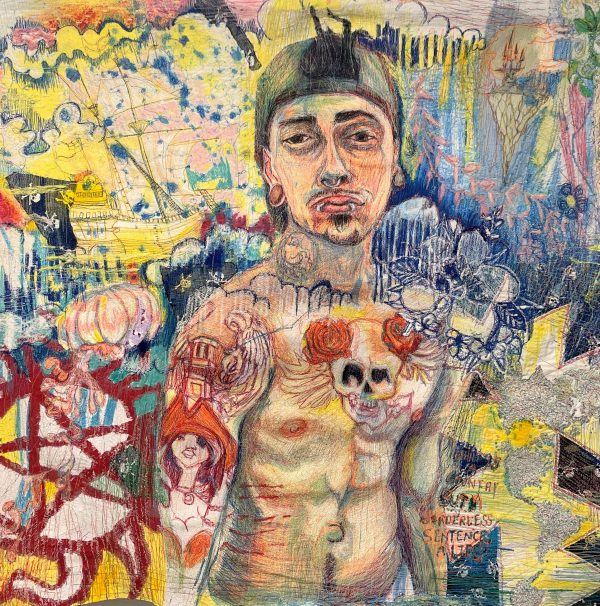
What do your choice of images mean to you?
I am interested in masculinity in the present day, especially as that word ‘Masculinity’ is so fluid in meaning. It’s understanding depends on who is using the term and who is receiving the term. We are abandoning rigid archaic binary terms to describe gender and identity. I identify with being described as a man and I am Cis, white and gay. I present myself in my own brand of ‘masculinity’ and some would accept that description of me while others may reject it. They may perceive my masculinity as something which is non-traditional and other. The men in this series all share stories about themselves through either body tattoos or facial tattoos. They all assert different styles of masculinity. The series aims to explore a range in identity. I’ve used men with tattoos as a specific cluster or ‘tribe’ that geographically spread across the world, but connected all virtually through hash tags on Instagram.
Do you look at your work with an eye toward it like what can and can’t be visually quoted? In other words what you will or won’t cut out?
I struggle with editing myself, in this series my process has been to focus on the male form first and then surround the figure with complimenting images into a college. The aim is to link to the themes and concepts within the piece. I would like to get better at distilling my ideas into concise concepts. I worry that I can dilute a piece with too many concepts. I do however want to make a piece discoverable so that layers to the meaning with the work is revealed within each image and series as a whole. I don’t want to reproduce a picture from Instagram I want to make an artwork which has been inspired by content from that platform.
Do you have any secrets in your work you will tell us?
I do have a sentence in Morse Code stitched into the piece titled Xochipilli. It is hidden near an image of Jupiter and Ganymede which is based on an image of the ‘Rape of Ganymede’ by Michelangelo Buonarroti. The model has a tattoo sleeve of the planets going how his arm. In the piece these planets have started to come away from his tattoo. I then added the reference from the Planet Jupiter with to link to the myth of Jupiter and Ganymede as a visual clue to queer narratives within history. Using these two visual reference points to show how symbols like planets have used as methods of story telling historically. These narratives change and evolve with time depending on the person telling the story and who receives the story.

How do you hope history treats your work?
I hope these pieces out last my life time. I hope they help provide a snap shot of interesting male portraits within history. I am particularly proud of what I have achieved with Artist-Activist. The portrait is of Yves Mathieu East who is both an artist and activist. I really hope he is recognised in history for his contributions to making the world a better place. For me he is someone who deserves celebrity status, I feel that social media can celebrate and champion certain individuals on merits which are connected to very commercial outputs. My hope is that through time we learn to move away from valuing people’s contributions based on commerciality and popularity. I hope we move toward democratically championing people who have supported the world in becoming better in some way.
Where can we find you and your work?
At my blog, on Instagram and Twitter.
Manbroidery was created with the support and wisdom of the magnificent Bascom Hogue.
Are you a manbroiderer with worthwhile work to share? Do you know a man who stitches and ought to be featured in this column?
Get in touch with us and we’ll and you to the growing ranks of marvellous manbroiderers!


